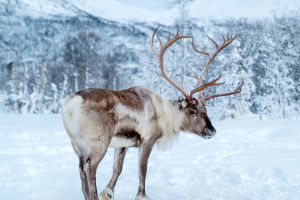Imagine standing outside in freezing winds, your breath turning to ice before your eyes. Now, picture living in that world year-round. That's life for Arctic animals, where temperatures can drop below -40°F, and survival depends on incredible adaptations.
From fur and blubber to clever behaviors, these creatures have evolved to endure one of the harshest environments on Earth.
1. Thick Fur and Blubber: Nature's Insulation
Many Arctic animals rely on dense fur and a layer of blubber to stay warm. Seals and walruses also use blubber to float in freezing seas and conserve body heat, making it a crucial survival tool for both swimming and resting.
2. Compact Body Shapes and Small Extremities
Arctic species often follow a rule known as Allen's Rule: animals in cold climates tend to have shorter limbs, ears, and tails to reduce heat loss. Snowshoe hares, Arctic foxes, and lemmings all exhibit this pattern. Smaller extremities mean less surface area for heat to escape, helping them maintain core body temperature. In addition, fur-covered paws or tails act as natural mufflers or boots, providing extra protection against snow and ice.
3. Seasonal Camouflage and Fur Color Changes
Staying hidden from predators—or sneaking up on prey—is vital in the Arctic. Many animals, like Arctic foxes and snowshoe hares, change fur color with the seasons. White winter coats blend with snow, while brown or gray summer coats match the tundra and rocks. This adaptation not only protects them from predators but also allows them to hunt effectively without being easily detected.
4. Hibernation and Torpor: Conserving Energy
Some Arctic animals avoid extreme cold by slowing their metabolism. Ground squirrels and Arctic groundhogs enter hibernation, reducing energy needs during the harshest months. Torpor, a temporary drop in metabolic rate, is another strategy used by smaller birds and mammals. By conserving energy and staying inactive during periods of extreme cold or food scarcity, these animals increase their chances of survival.
5. Behavioral Adaptations: Smart Survival
Arctic animals often rely on behavior as much as physical traits. Caribou migrate hundreds of miles to reach areas with available food. Some species burrow beneath the snow to stay insulated, creating tunnels that trap heat and shield them from the wind. These behaviors show that surviving the Arctic isn't just about what you have—it's about how you use it.
6. Specialized Diets and Hunting Techniques
Food is scarce in the Arctic, so animals have evolved unique ways to find and consume it. Arctic foxes scavenge leftovers from larger predators and dig through snow to find hidden rodents. Even small insects or plant matter can become important food sources during summer months. Adaptability in diet is key to enduring long winters and unpredictable conditions.
Lessons from Arctic Adaptations
Studying these animals reveals nature's ingenuity in overcoming extreme challenges. Physical features, behavioral strategies, and diet flexibility all work together to ensure survival. Humans can take inspiration from these adaptations, learning about resilience, preparation, and efficiency.
1. Insulation is essential: fur, blubber, and compact body parts reduce heat loss.
2. Timing and energy management matter: hibernation and torpor conserve resources.
3. Smart behaviors enhance survival: migration, camouflage, and burrowing make a difference.
Reflection on Arctic Life
Life in the Arctic may seem impossible to us, but the animals that live there thrive through a combination of physical traits and smart strategies. Observing their adaptations reminds us how evolution shapes not just survival but efficiency and resourcefulness. Next time you see a walrus basking on an ice floe or an Arctic fox disappearing into the snow, think about the incredible design behind their existence—nature's ultimate lessons in resilience and adaptation.


